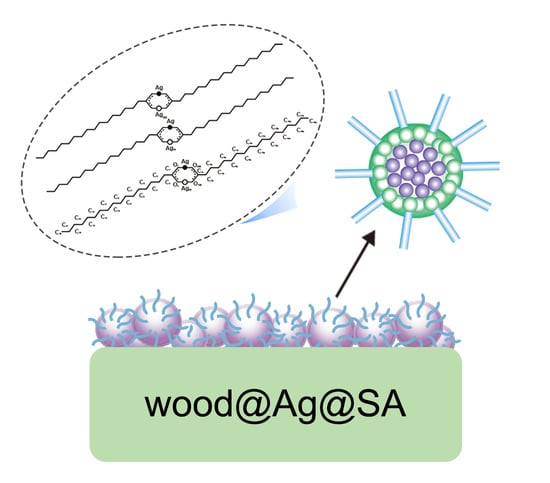A Superhydrophobic, Antibacterial, and Durable Surface of Poplar Wood
Abstract
1. Introduction
2. Materials and Methods
2.1. Materials
2.2. Methods
2.3. Analysis of Reaction Mechanism
2.4. Surface Morphology and Wettability Analysis
2.5. Antimicrobial Test
2.6. Stability Test
2.7. Contaminant Resistance Test and Durability Testing
3. Results
3.1. Analysis of Reaction Mechanism
3.1.1. FTIR and XRD
3.1.2. XPS
3.1.3. Analysis of Modification Mechanism
3.2. Surface Morphology and Wettability Analysis
3.3. Antimicrobial Test
3.4. Stability Test
3.5. Contaminant Resistance Test and Durability Test
4. Conclusions
Author Contributions
Funding
Institutional Review Board Statement
Informed Consent Statement
Data Availability Statement
Acknowledgments
Conflicts of Interest
References
- Spear, M.J.; Curling, S.F.; Dimitriou, A.; Ormondroyd, G.A. Review of Functional Treatments for Modified Wood. Coatings 2021, 11, 327. [Google Scholar] [CrossRef]
- Liu, X.; Timar, M.C.; Varodi, A.M. A comparative study on the artificial UV and natural ageing of beeswax and Chinese wax and influence of wax finishing on the ageing of Chinese Ash (Fraxinus mandshurica) wood surfaces. J. Photochem. Photobiol. B-Biol. 2019, 201. [Google Scholar] [CrossRef] [PubMed]
- Li, R.; Fang, L.; Xu, W.; Xiong, X.; Wang, X. Effect of Laser Irradiation on the Surface Wettability of Poplar Wood. Sci. Adv. Mater. 2019, 11, 655–660. [Google Scholar] [CrossRef]
- Janesch, J.; Arminger, B.; Gindl-Altmutter, W.; Hansmann, C. Superhydrophobic coatings on wood made of plant oil and natural wax. Prog. Org. Coat. 2020, 148. [Google Scholar] [CrossRef]
- Zhan, K.; Lu, Q.; Xia, S.; Guo, C.; Zhao, S.; Gao, W.; Yang, L.; Morrell, J.J.; Yi, T.; Xie, L.; et al. A cost effective strategy to fabricate STA@PF@Cu2O hierarchical structure on wood surface: Aimed at superhydrophobic modification. Wood Sci. Technol. 2021, 55, 565–583. [Google Scholar] [CrossRef]
- Yang, R.; Zuo, S.; Song, B.; Mao, H.; Huang, Z.; Wu, Y.; Cai, L.; Ge, S.; Lian, H.; Xia, C. Hollow Mesoporous Microspheres Coating for Super-Hydrophobicity Wood with High Thermostability and Abrasion Performance. Polymers 2020, 12, 2856. [Google Scholar] [CrossRef]
- Feng, X.; Wu, Z.; Sang, R.; Wang, F.; Zhu, Y.; Wu, M. Surface Design of Wood-Based Board to Imitate Wood Texture Using 3D Printing Technology. Bioresources 2019, 14, 8196–8211. [Google Scholar] [CrossRef]
- Huang, C.; Dong, H.; Zhang, Z.; Bian, H.; Yong, Q. Procuring the nano-scale lignin in prehydrolyzate as ingredient to prepare cellulose nanofibril composite film with multiple functions. Cellulose 2020, 27, 9355–9370. [Google Scholar] [CrossRef]
- Zheng, Y.; Yu, Y.; Lin, W.; Jin, Y.; Huang, C. Enhancing the enzymatic digestibility of bamboo residues by biphasic phenoxyethanol-acid pretreatment. J. Bioresour. Technol. 2021, 325, 124691. [Google Scholar] [CrossRef]
- Deng, Y.; Mager, D.; Bai, Y.; Zhou, T.; Liu, Z.; Wen, L.; Wu, Y.; Korvink, J.G. Inversely designed micro-textures for robust Cassie-Baxter mode of super-hydrophobicity. Comput. Methods Appl. Mech. Eng. 2018, 341, 113–132. [Google Scholar] [CrossRef]
- Lu, Z.; Xu, L.; He, Y.; Zhou, J. One-step facile route to fabricate functionalized nano-silica and silicone sealant based transparent superhydrophobic coating. Thin Solid Film. 2019, 692. [Google Scholar] [CrossRef]
- Zhang, W.; Jiang, S.; Lv, D. Fabrication and characterization of a PDMS modified polyurethane/Al composite coating with super-hydrophobicity and low infrared emissivity. Prog. Org. Coat. 2020, 143. [Google Scholar] [CrossRef]
- Zhang, Y.; Zhang, Y.; Cao, Q.; Wang, C.; Yang, C.; Li, Y.; Zhou, J. Novel porous oil-water separation material with super-hydrophobicity and super-oleophilicity prepared from beeswax, lignin, and cotton. Sci. Total Environ. 2020, 706. [Google Scholar] [CrossRef] [PubMed]
- Zhang, M.; Zhao, W.; Zhang, X.; Li, Z.; Yu, L.; Li, X.; Zhang, Z. Nonfluoride-modified halloysite nanotube-based hybrid: Potential for acquiring super-hydrophobicity and improving flame retardancy of epoxy resin. J. Nanostructure Chem. 2021. [Google Scholar] [CrossRef]
- Jin, C.; Li, J.; Han, S.; Wang, J.; Sun, Q. A durable, superhydrophobic, superoleophobic and corrosion-resistant coating with rose-like ZnO nanoflowers on a bamboo surface. Appl. Surf. Sci. 2014, 320, 322–327. [Google Scholar] [CrossRef]
- Ma, T.; Li, L.; Mei, C.; Wang, Q.; Guo, C. Construction of sustainable, fireproof and superhydrophobic wood template for efficient oil/water separation. J. Mater. Sci. 2021, 56, 5624–5636. [Google Scholar] [CrossRef]
- Zhang, D.; Jin, X.-Z.; Huang, T.; Zhang, N.; Qi, X.-D.; Yang, J.-H.; Zhou, Z.-W.; Wang, Y. Electrospun Fibrous Membranes with Dual-Scaled Porous Structure: Super Hydrophobicity, Super Lipophilicity, Excellent Water Adhesion, and Anti-Icing for Highly Efficient Oil Adsorption/Separation. Acs. Appl. Mater. Interfaces 2019, 11, 5073–5083. [Google Scholar] [CrossRef]
- Gregorcic, P.; Conradi, M.; Hribar, L.; Hocevar, M. Long-Term Influence of Laser-Processing Parameters on (Super)hydrophobicity Development and Stability of Stainless-Steel Surfaces. Materials 2018, 11, 2240. [Google Scholar] [CrossRef]
- Kundu, D.; Banerjee, D.; Ghosh, S.; Tewari, R.C.; Das, N.S.; Das, B.; Chattopadhyay, K.K. Achievement of nearly super hydrophobicity in plasma enhanced chemical vapour deposited one and two dimensional carbon nanostructures. Phys. E-Low-Dimens. Syst. Nanostruct. 2019, 108, 7–14. [Google Scholar] [CrossRef]
- Wen, Y.; Kong, D.; Shang, W.; Ma, M.; Jiang, J.; Li, J.; Peng, N. Effect of bis-(3-triethoxysilylpropyl)-tetrasulfide on Super-Hydrophobicity and Corrosion Resistance of Self-Assembled Monolayers on 6061 Aluminum Alloys. Int. J. Electrochem. Sci. 2019, 14, 6018–6031. [Google Scholar] [CrossRef]
- Gong, W.; Wang, Y.; Chen, Y.; Li, X.; Li, K.; Wang, Z.; Yan, Y. A Study of the Truncated Square Pyramid Geometry for Enhancement of Super-hydrophobicity. J. Bionic Eng. 2020, 17, 843–850. [Google Scholar] [CrossRef]
- Wang, N.; Wang, Q.; Xu, S.; Zheng, X. Fabrication of multifunctional amphiphobic surfaces on copper substrates. Colloid Surf. A-Physicochem. Eng. Asp. 2019, 577, 509–516. [Google Scholar] [CrossRef]
- Zou, L.; Wang, H.; Zhu, X.; Ding, Y.; Liao, Q. Active effect of super-hydrophobicity on droplet nucleate boiling. Int. J. Heat Mass Transf. 2020, 157. [Google Scholar] [CrossRef]
- Faraz, M.; Ansari, M.Z.; Khare, N. Synthesis of nanostructure manganese doped zinc oxide/polystyrene thin films with excellent stability, transparency and super-hydrophobicity. Mater. Chem. Phys. 2018, 211, 137–143. [Google Scholar] [CrossRef]
- Li, C.; Sun, Y.; Cheng, M.; Sun, S.; Hu, S. Fabrication and characterization of a TiO2/polysiloxane resin composite coating with full-thickness super-hydrophobicity. Chem. Eng. J. 2018, 333, 361–369. [Google Scholar] [CrossRef]
- Lv, D.; Fang, N.; Zhang, W. A PDMS modified polyurethane/Ag composite coating with super-hydrophobicity and low infrared emissivity. Infrared Phys. Technol. 2020, 108. [Google Scholar] [CrossRef]
- Betar, B.O.; Alsaadi, M.A.; Chowdhury, Z.Z.; Aroua, M.K.; Mjalli, F.S.; Dimyati, K.; Hindia, M.N.; Elfghi, F.M.; Ahmed, Y.M.; Abbas, H.F. Bimetallic Mo–Fe Co-Catalyst-Based Nano-Carbon Impregnated on PAC for Optimum Super-Hydrophobicity. Symmetry 2020, 12, 1242. [Google Scholar] [CrossRef]
- Saharudin, K.A.; Sreekantan, S.; Basiron, N.; Chun, L.K.; Kumaravel, V.; Abdullah, T.K.; Ahmad, Z.A. Improved super-hydrophobicity of eco-friendly coating from palm oil fuel ash (POFA) waste. Surf. Coat. Technol. 2018, 337, 126–135. [Google Scholar] [CrossRef]
- Sri, K.A.; Deeksha, P.; Deepika, G.; Nishanthini, J.; Hikku, G.S.; Shilpa, A.S.; Jeyasubramanian, K.; Murugesan, R. Super-hydrophobicity: Mechanism, fabrication and its application in medical implants to prevent biomaterial associated infections. J. Ind. Eng. Chem. 2020, 92, 1–17. [Google Scholar] [CrossRef]
- Wang, N.; Wang, Q.; Xu, S.; Qu, L.; Shi, Z. Robust superhydrophobic wood surfaces with mechanical durability. Colloid Surf. A-Physicochem. Eng. Asp. 2021, 608. [Google Scholar] [CrossRef]
- Dányádi, L.; Móczó, J.; Pukánszky, B. Effect of various surface modifications of wood flour on the properties of PP/wood composites. Compos. Part. A Appl. Sci. Manuf. 2010, 41, 199–206. [Google Scholar] [CrossRef]
- Sharma, G.; Kumar, A.; Naushad, M.; Al-Misned, F.A.; El-Serehy, H.A.; Ghfar, A.A.; Sharma, K.R.; Si, C.; Stadler, F.J. Graft Copolymerization of Acrylonitrile and Ethyl Acrylate onto Pinus Roxburghii Wood Surface Enhanced Physicochemical Properties and Antibacterial Activity. J. Chem. 2020, 2020. [Google Scholar] [CrossRef]
- Hansmann, C.; Weichslberger, G.; Gindl, W. A two-step modification treatment of solid wood by bulk modification and surface treatment. Wood Sci. Technol. 2005, 39, 502–511. [Google Scholar] [CrossRef]
- Yang, L.; Liu, H. Effect of a Combination of Moderate-Temperature Heat Treatment and Subsequent Wax Impregnation on Wood Hygroscopicity, Dimensional Stability, and Mechanical Properties. Forests 2020, 11, 920. [Google Scholar] [CrossRef]
- Liu, X.; Wu, Z.; Zhang, J. The Effects of Heating Treatment on the Tensile Properties of Palm Petioles Fiber. Bioresources 2017, 12, 1335–1343. [Google Scholar] [CrossRef][Green Version]
- Epmeier, H.; Westin, M.; Rapp, A. Differently modified wood: Comparison of some selected properties. Scand. J. For. Res. 2011, 19, 31–37. [Google Scholar] [CrossRef]
- Cheng, L.; Ren, S.; Lu, X. Application of Eco-Friendly Waterborne Polyurethane Composite Coating Incorporated with Nano Cellulose Crystalline and Silver Nano Particles on Wood Antibacterial Board. Polymers 2020, 12, 407. [Google Scholar] [CrossRef] [PubMed]
- Xiong, X.; Ma, Q.; Yuan, Y.; Wu, Z.; Zhang, M. Current situation and key manufacturing considerations of green furniture in China: A review. J. Clean Prod. 2020, 267. [Google Scholar] [CrossRef]
- El-Hefny, M.; Salem, M.Z.M.; Behiry, S.I.; Ali, H.M. The Potential Antibacterial and Antifungal Activities of Wood Treated with Withania somnifera Fruit Extract, and the Phenolic, Caffeine, and Flavonoid Composition of the Extract According to HPLC. Processes 2020, 8, 113. [Google Scholar] [CrossRef]
- Ashmawy, N.A.; Salem, M.Z.M.; El Shanhorey, N.; Al-Huciail, A.A.; Ali, H.M.; Behiry, S.I. Eco-friendly Wood-biofungicidal and Antibacterial Activities of Various Coccoloba uvifera L. Leaf Extracts: HPLC Analysis of Phenolic and Flavonoid Compounds. Bioresources 2020, 15, 4165–4187. [Google Scholar] [CrossRef]
- Chen, R.; Zhang, Y.; Xie, Q.; Chen, Z.; Ma, C.; Zhang, G. Transparent Polymer-Ceramic Hybrid Antifouling Coating with Superior Mechanical Properties. Adv. Funct. Mater. 2021. [Google Scholar] [CrossRef]
- Ivask, A.; Bondarenko, O.; Jepihhina, N.; Kahru, A. Profiling of the reactive oxygen species-related ecotoxicity of CuO, ZnO, TiO2, silver and fullerene nanoparticles using a set of recombinant luminescent Escherichia coli strains: Differentiating the impact of particles and solubilised metals. Anal. Bioanal. Chem. 2010, 398, 701–716. [Google Scholar] [CrossRef]
- Zhang, F.; Lee, M.H.; Huang, Y.X.; Keller, A.A.; Majumdar, S.; Cervantes-Aviles, P.; Tang, X.X.; Yin, S.Q. Effective water disinfection using magnetic barium phosphate nanoflakes loaded with Ag nanoparticles. J. Clean Prod. 2019, 218, 173–182. [Google Scholar] [CrossRef]
- Yang, J.; Chen, Y.; Jia, X.; Li, Y.; Wang, S.; Song, H. Wood-Based Solar Interface Evaporation Device with Self-Desalting and High Antibacterial Activity for Efficient Solar Steam Generation. Acs. Appl. Mater. Interfaces 2020, 12, 47029–47037. [Google Scholar] [CrossRef]
- Kubo, A.L.; Capjak, I.; Vrcek, I.V.; Bondarenko, O.M.; Kurvet, I.; Vija, H.; Ivask, A.; Kasemets, K.; Kahru, A. Antimicrobial potency of differently coated 10 and 50 nm silver nanoparticles against clinically relevant bacteria Escherichia coli and Staphylococcus aureus. Colloid Surf. B-Biointerfaces 2018, 170, 401–410. [Google Scholar] [CrossRef]
- Duan, X.; Liu, S.; Huang, E.; Shen, X.; Wang, Z.; Li, S.; Jin, C. Superhydrophobic and antibacterial wood enabled by polydopamine-assisted decoration of copper nanoparticles. Colloid Surf. A-Physicochem. Eng. Asp. 2020, 602. [Google Scholar] [CrossRef]
- Gao, L.; Lu, Y.; Li, J.; Sun, Q. Superhydrophobic conductive wood with oil repellency obtained by coating with silver nanoparticles modified by fluoroalkyl silane. Holzforschung 2016, 70, 63–68. [Google Scholar] [CrossRef]
- Park, C.; Na, J.; Han, M.; Kim, E. Transparent Electrochemical Gratings from a Patterned Bistable Silver Mirror. ACS Nano 2017, 11, 6977–6984. [Google Scholar] [CrossRef]
- Chen, X.; Zhang, B.; Xie, L.; Wang, F. MWCNTs polyurethane sponges with enhanced super-hydrophobicity for selective oil-water separation. Surf. Eng. 2020, 36, 651–659. [Google Scholar] [CrossRef]
- Cai, T.; Shen, X.; Huang, E.; Yan, Y.; Shen, X.; Wang, F.; Wang, Z.; Sun, Q. Ag nanoparticles supported on MgAl-LDH decorated wood veneer with enhanced flame retardancy, water repellency and antimicrobial activity. Colloid Surf. A-Physicochem. Eng. Asp. 2020, 598, 9. [Google Scholar] [CrossRef]
- Ou, J.; Zhao, G.; Wang, F.; Li, W.; Lei, S.; Fang, X.; Siddiqui, A.R.; Xia, Y.; Amirfazli, A. Durable Superhydrophobic Wood via One-Step Immersion in Composite Silane Solution. Acs. Omega 2021, 6, 7266–7274. [Google Scholar] [CrossRef]
- Zhang, L.; Lin, N.; Zou, J.; Lin, X.; Liu, Z.; Yuan, S.; Yu, Y.; Wang, Z.; Zeng, Q.; Chen, W.; et al. Super-hydrophobicity and corrosion resistance of laser surface textured AISI 304 stainless steel decorated with Hexadecyltrimethoxysilane (HDTMS). Opt. Laser Technol. 2020, 127. [Google Scholar] [CrossRef]
- Tien, H.; Huang, Y.; Yang, S.; Wang, J.; Ma, C. The production of graphene nanosheets decorated with silver nanoparticles for use in transparent, conductive films. Carbon 2011, 49, 1550–1560. [Google Scholar] [CrossRef]
- Yang, C.; Cui, S.; Weng, Y.; Wu, Z.; Liu, L.; Ma, Z.; Tian, X.; Fu, R.; Chu, P.K.; Wu, Z. Scalable superhydrophobic T-shape micro/nano structured inorganic alumina coatings. Chem. Eng. J. 2021, 409. [Google Scholar] [CrossRef]
- Song, P.; Wang, C.; Sun, Y.; Bousquet, A.; Tomasella, E. Broadband and Wide-Temperature-Range Thermal Emitter with Super-Hydrophobicity Based on Oxidized High-Entropy Film. Acs. Appl. Mater. Interfaces 2020, 12, 4123–4128. [Google Scholar] [CrossRef]
- Huang, L.; Ling, L.; Su, J.; Song, Y.; Wang, Z.; Tang, B.; Westerhoff, P.; Ye, R. Laser-Engineered Graphene on Wood Enables Efficient Antibacterial, Anti-Salt-Fouling, and Lipophilic-Matter-Rejection Solar Evaporation. ACS Appl. Mater. Interfaces 2020, 12, 51864–51872. [Google Scholar] [CrossRef] [PubMed]
- Misuri, F.; Marri, L. Antibacterial activity of wood distillate from residual virgin chestnut biomass. Eur. J. Wood Wood Prod. 2020. [Google Scholar] [CrossRef]
- Wang, N.; Wan, Q.; Xu, S.; Luan, J. Flexible films with wrinkled micro-nano hierarchical structures having stable superhydrophobicity under external loading. J. Mater. Sci. 2020, 55, 9623–9637. [Google Scholar] [CrossRef]
- Nagarajappa, G.B.; Pandey, K.K. UV resistance and dimensional stability of wood modified with isopropenyl acetate. J. Photochem. Photobiol. B 2016, 155, 20–27. [Google Scholar] [CrossRef]
- Yue, D.; Lin, S.; Cao, M.; Lin, W.; Zhang, X. Fabrication of transparent and durable superhydrophobic polysiloxane/SiO2 coating on the wood surface. Cellulose 2021, 28, 3745–3758. [Google Scholar] [CrossRef]
- Chen, H.; Zhang, W.; Wang, X.; Wang, H.; Wu, Y.; Zhong, T.; Fei, B. Effect of alkali treatment on wettability and thermal stability of individual bamboo fibers. J. Wood Sci. 2018, 64, 398–405. [Google Scholar] [CrossRef]
- Liu, X.; Timar, M.C.; Varodi, A.M. An investigation of accelerated temperature-induced ageing of four wood species: Colour and FTIR. Wood Sci. Technol. 2017, 51, 357–378. [Google Scholar] [CrossRef]
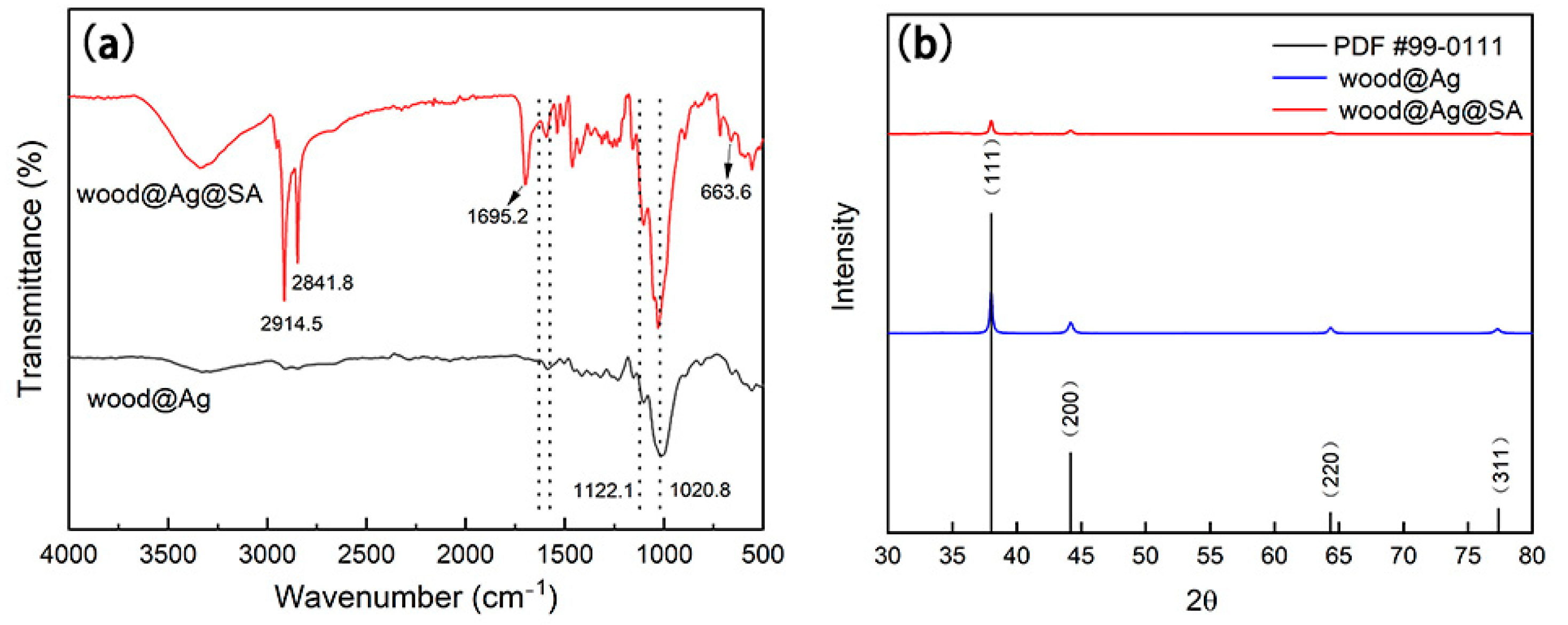
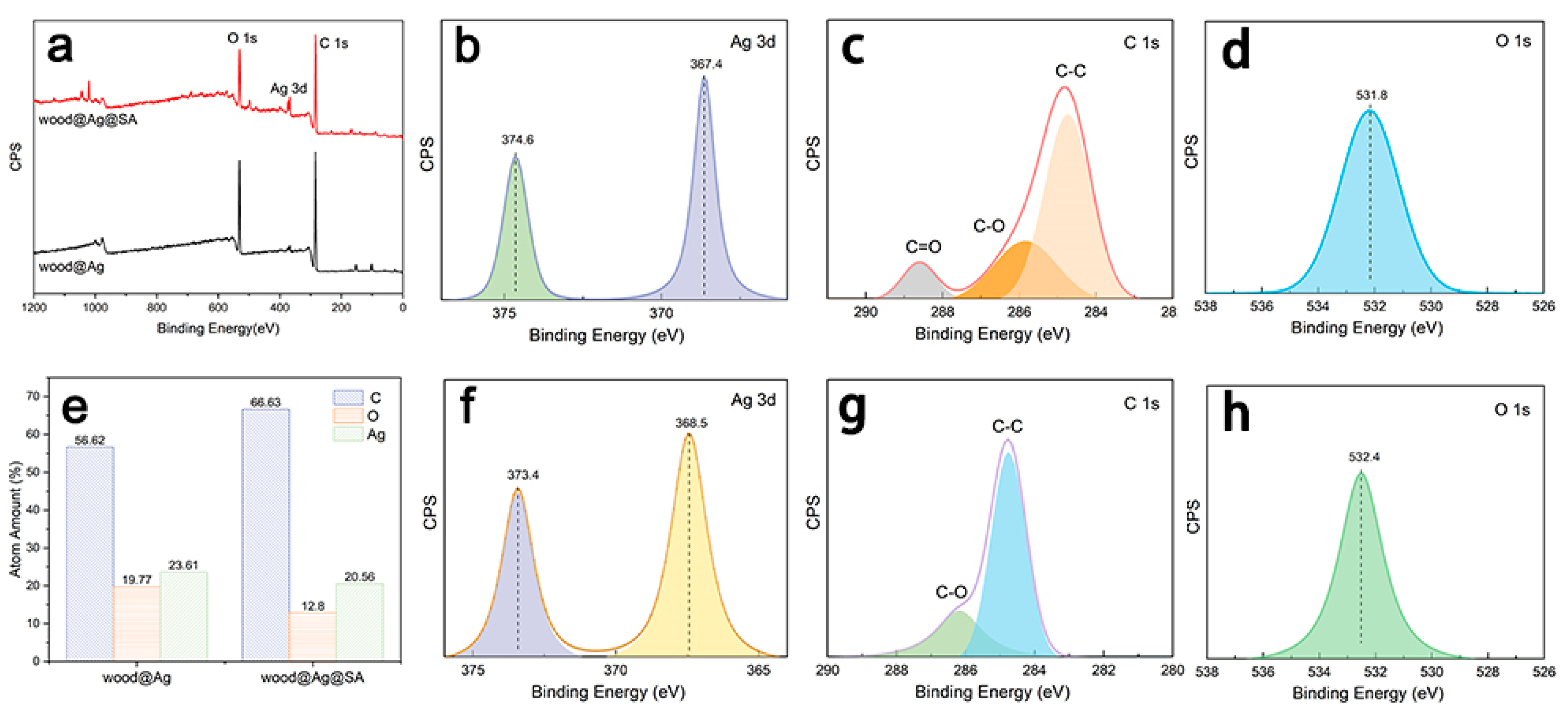
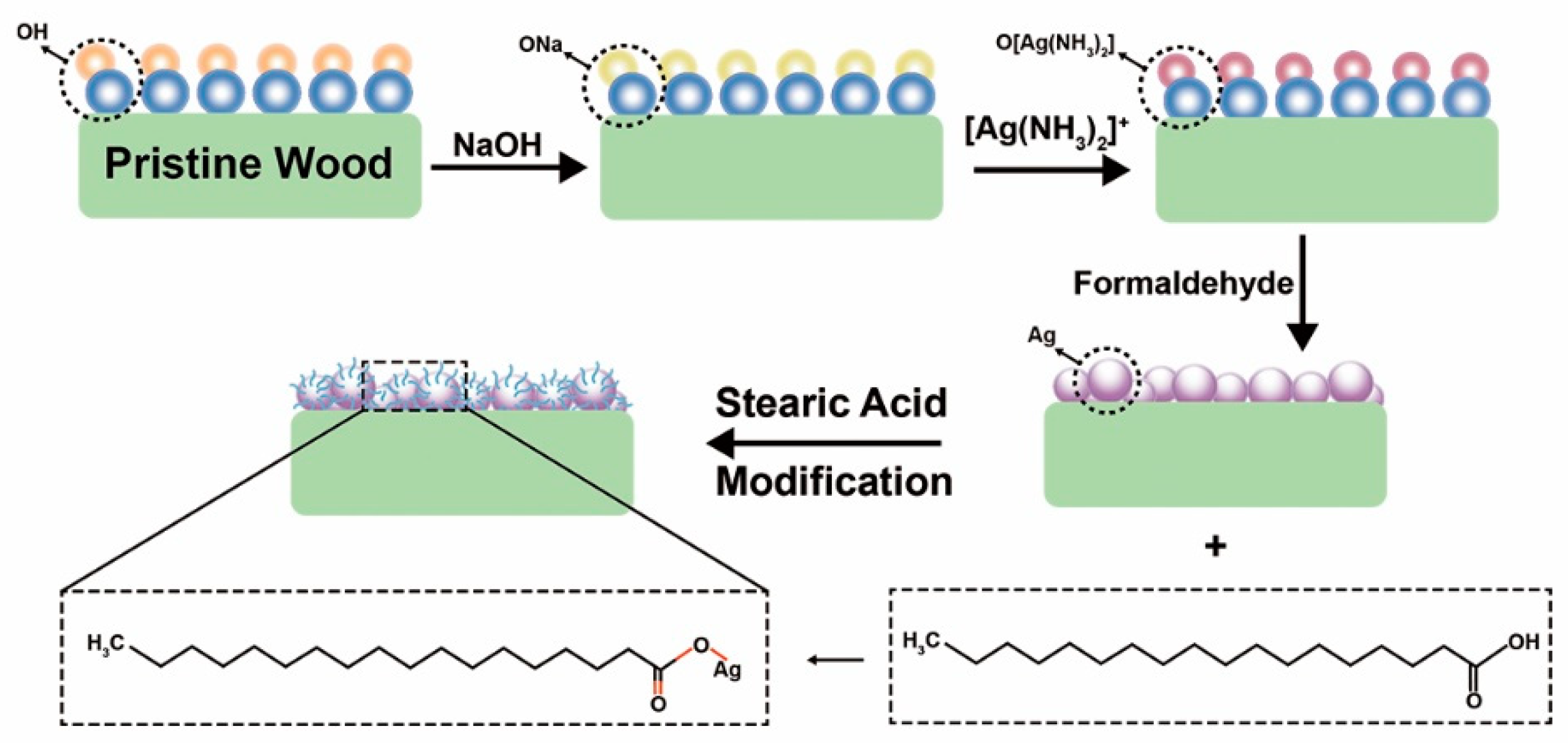

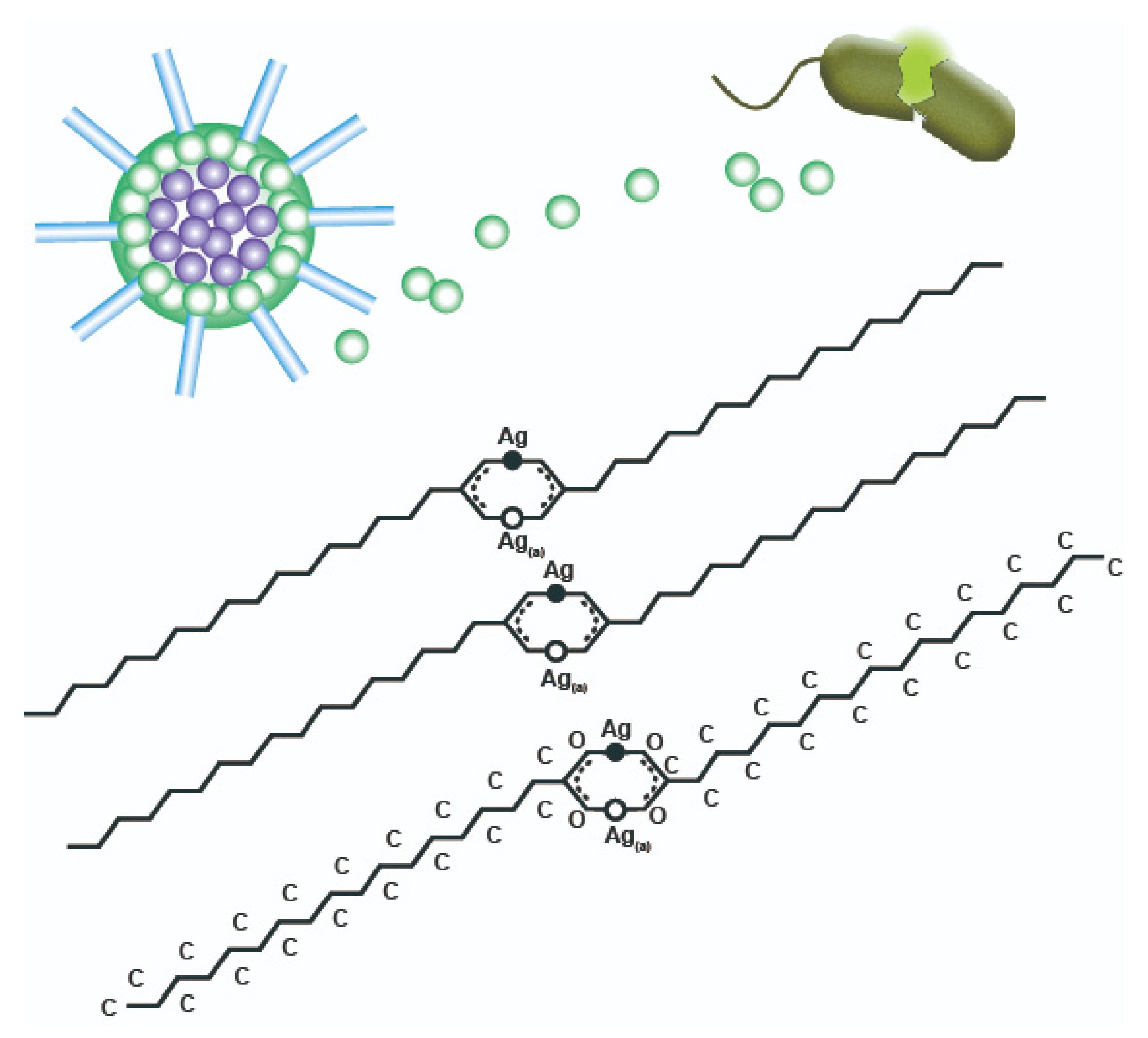
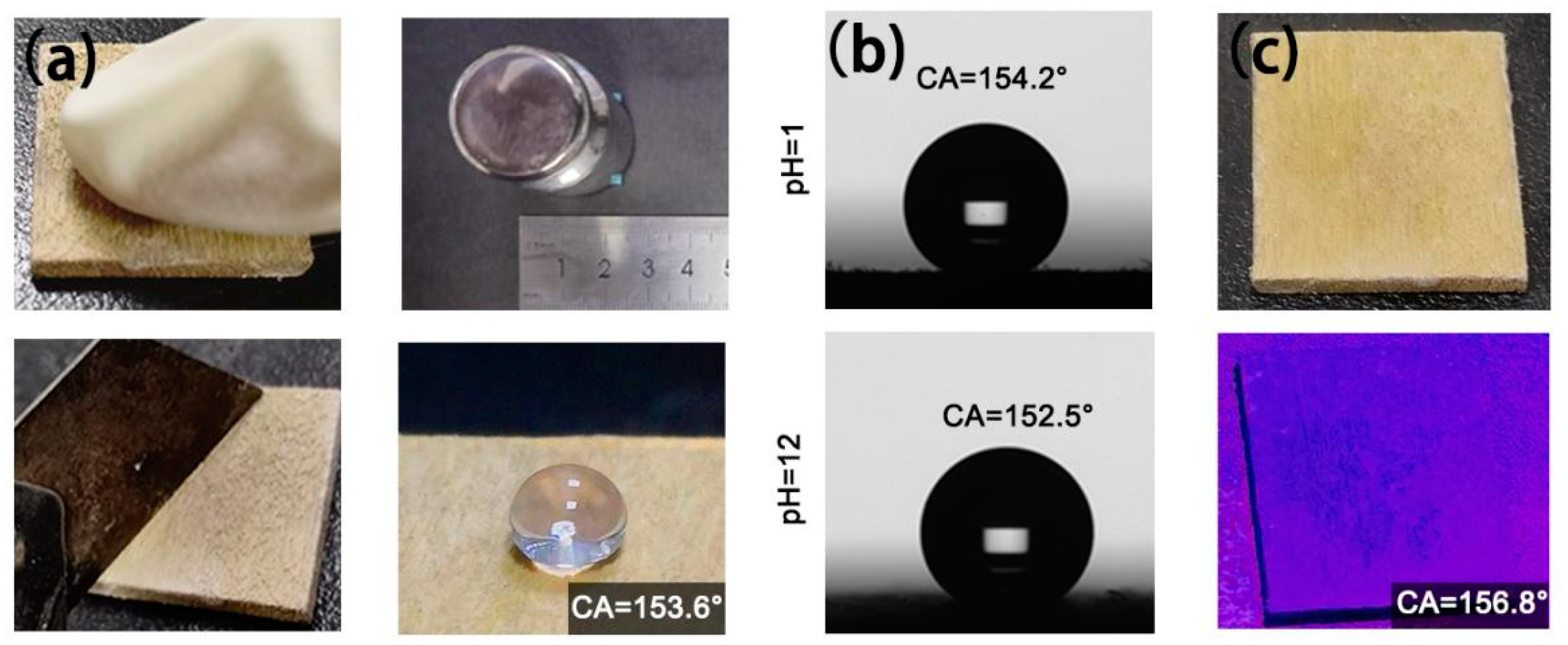
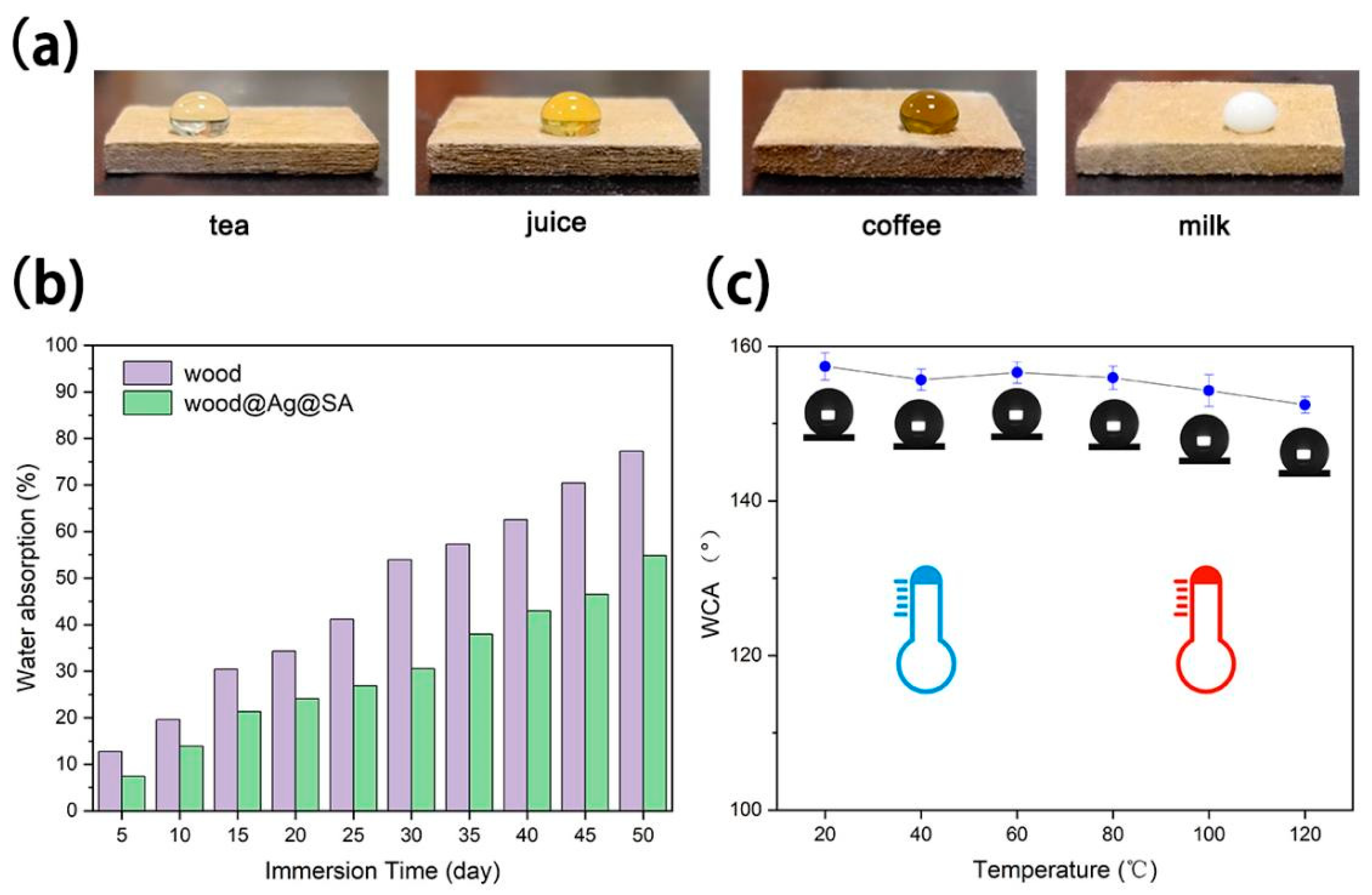
| Name of the Sample | Colony Forming Unit (CFU) | Antimicrobial Rate of Staphylococcus Aureus (%) |
|---|---|---|
| wood@Ag@SA | 500 | 99.9 |
Publisher’s Note: MDPI stays neutral with regard to jurisdictional claims in published maps and institutional affiliations. |
© 2021 by the authors. Licensee MDPI, Basel, Switzerland. This article is an open access article distributed under the terms and conditions of the Creative Commons Attribution (CC BY) license (https://creativecommons.org/licenses/by/4.0/).
Share and Cite
Wu, X.; Yang, F.; Gan, J.; Kong, Z.; Wu, Y. A Superhydrophobic, Antibacterial, and Durable Surface of Poplar Wood. Nanomaterials 2021, 11, 1885. https://doi.org/10.3390/nano11081885
Wu X, Yang F, Gan J, Kong Z, Wu Y. A Superhydrophobic, Antibacterial, and Durable Surface of Poplar Wood. Nanomaterials. 2021; 11(8):1885. https://doi.org/10.3390/nano11081885
Chicago/Turabian StyleWu, Xinyu, Feng Yang, Jian Gan, Zhangqian Kong, and Yan Wu. 2021. "A Superhydrophobic, Antibacterial, and Durable Surface of Poplar Wood" Nanomaterials 11, no. 8: 1885. https://doi.org/10.3390/nano11081885
APA StyleWu, X., Yang, F., Gan, J., Kong, Z., & Wu, Y. (2021). A Superhydrophobic, Antibacterial, and Durable Surface of Poplar Wood. Nanomaterials, 11(8), 1885. https://doi.org/10.3390/nano11081885





